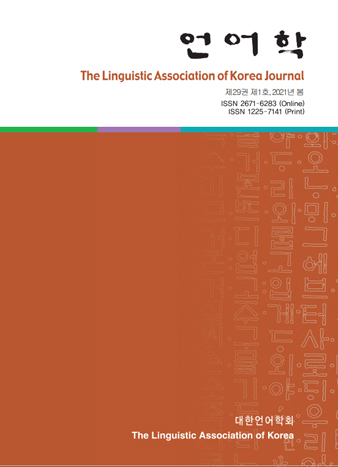대한언어학회 전자저널

29권 1호 (2021년 3월)
- 영한 표기법의 개선과 실제적 운용
-
이종민
Pages : 25-48
Abstract
Lee, Chongmin. (2021). A new proposal for the practical application of English-Korean transcriptions. The Linguistic Association of Korea Journal, 29(1), 25-48. This paper aims to review the given system of English-Korean transcription and to develop the revised version with the concepts of easiness and uniformity. Basically the vowel system should be simplified to reduce the syllable length in Korean, so the Korean people may use the imported words with uniformity. In the consonant system the positional variation of the same sound should be changed to be more consistent and recognizable among the Korean people. Often it has been assumed to maintain the idea that the foreign pronunciation should not be distorted. However, the proposed scheme has been devised to figure out how foreign words are transcribed more consistently. Though there are some exceptions existent in transcribed words, it can be concluded that the easiness and uniformity of English transcription can be systemized more effectively.
Keywords
# 영한표기법(English-Korean transcription) # 통일성(uniformity) # 영어 자음(English consonants) # 영어 모음(English vowels) # 수입된 단어(imported words) # 언어정책(language policy) # 언종차별(languageism)
References
- 국립국어원. (2017). 외래어표기법. (2017. 3. 28. 시행.)
- 국립국어원. (2000). 로마자 표기 용례 사전. (2000. 7. 7. 시행)
- 김병기. (2016). 북경인가, 베이징인가? 서울: 어문학사.
- 박종덕. (2015). 성공적인 국어 순화 정책을 위한 제언. 한글, 309, 219-248.
- 배주채. (2015). 국어 발음 정책과 발음 교육의 방향. 새국어생활, 25(1), 45-62.
- 유재원. (2005). 국어 순화, 왜 그리고 어떻게 해야 하나? 새국어생활, 15(1), 7-17.
- 이규태. (2012.) 영어발음의 한글발음표기를 통한 효과적인 영어 발음지도 연구: 성인 학습자를 중심으로. 한국외국어대학교 석사학위논문.
- 이상규. (2011). 「국어기본법」에 근거한 「외래어 표기법」의 문제. 국어국문학, 158, 135-182.
- 이상혁. (2002). 외래어의 개념 및 유형 설정 - 서구 외래어를 중심으로. 돈암어문학, 15, 101–123.
- 이송이. (2018). 영어 발음의 한글 표기 사용에 대한 인식 연구: 신문 기사를 중심으로. 언어학 연구, 46, 313-333.
- 이정복. (2008). 외래어 순화 정책의 방향-정부 활동을 중심으로. 어문학, 99, 327-66.
- 이종민. (2009). 가짜영어 진짜발음. 서울: 도서출판 역락.
- 이하얀. (2017). 국어 외래어 표기법의 문제점과 보완 방향. 언어와 정보사회, 30, 189–205.
- 정 국. (2002). 외래어 표기법과 발음법. 외국어교육연구논집, 17, 185-214.
- 정희창. (2015). 외래어 순화의 내용과 앞으로의 방향. 한국어학, 67, 89-104.
- 조남호. (2014). 한국어의 외래어 수용과 대응. 명지대학교 인문과학연구논총, 39, 813-38.
- 탁성숙. (2014). 한국어의 외래어수용에 관한 연구. 가천대학교 아시아문화연구, 36, 257-294.
- Jenkins, J. (2000). The phonology of English as an international language. Oxford: Oxford University Press.
- Lee, C. (2016). Languageism, linguistic diversity and language policy. The Linguistic Association of Korea Journal, 24(2). 197-208.
- Milroy, J., & Milroy, L. (1985). Authority in language. London: Routledge & Kegan Paul plc [sic].
- Moyer, A. (2015). Foreign accent: The phenomenon of non-native speech. Cambridge: Cambridge University Press.
- Wright, S. (2016). Language policy and language planning: From nationalism to globalisation (2nd ed.). Hampshire, the United Kingdom: Palgrave Macmillan.